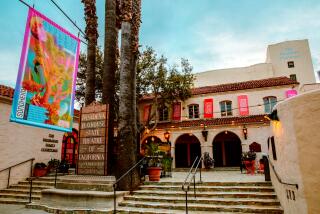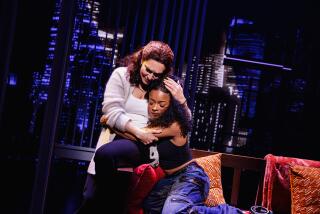Season’s Greetings, San Diego, From . . . : . . . THE ACTORS
SAN DIEGO — There are things you can count on as the holidays near. Candy canes. Egg nog. “It’s A Wonderful Life” reruns. Presents under the tree or beside the menorah.
There are shows you can count on, too. Back for the 14th year is the San Diego Repertory Theatre’s adaptation of Charles Dickens’ “A Christmas Carol.” Back for the 12th year is the Lamb’s Players Theatre’s “A Festival of Christmas.”
And hoping to become annual events are “Black Nativity,” directed for the second time in two years by Floyd Gaffney, this year at the Educational Cultural Complex and the Del Mar Theatre Ensemble’s first Christmas show, a potpourri of offerings that blends “Peter and the Wolf,” “A Child’s Christmas in Wales” and “How the Grinch Stole Christmas” with a segment on lighting a menorah and making potato latkes--a popular Hanukkah treat.
In keeping with the delicious anticipation of the unknown offered by wrapped gifts, even the oldies this year will offer new twists.
“A Christmas Carol,” playing Nov. 30-Dec. 24 at the Rep, is still adapted from the Charles Dickens’ novella by Douglas Jacobs, artistic director of the company, but associate producer Walter Schoen has set the play not in a poor community in Victorian England, but in a poor community in San Diego in which the homeless congregate.
“A Festival of Christmas,” a series of plays designed by Lamb’s resident playwright Kerry Cederberg Meads to showcase old English Christmas carols while capturing the Christmas spirit across the centuries, will be a brand new play this year, playing Thursday through Dec. 23.
In other words, this year tradition doesn’t mean repetition.
Schoen said he thought bringing the message of modern poverty home in his direction of “A Christmas Carol” would actually be more in keeping with the spirit of Dickens’ original work than the old-fashioned productions.
Dickens, after all, was a crusader against poverty and homelessness and social injustice in his own time. He wrote “A Christmas Carol” as a way to persuade the wealthy Scrooges of his time to show compassion for the poverty-stricken Bob Cratchits.
“It allows us to get to the heart of Dickens because the heart of Dickens is not in the entrapments of pre-Victorian London,” said Schoen. “The heart of Dickens is something much more universal, and that’s what we are aiming for.”
Schoen said he isn’t changing Jacobs’ adaptation at all. Instead, he is going for a “Man of La Mancha” effect in which a group of homeless people are looking for trash to burn to keep them warm in the winter. They come across Dickens’ “A Christmas Carol” and, before they burn it, they decide to read it.
As they read it, they start imagining it, using the flotsam and jetsam of the streets--a shopping cart, a manhole cover, a grate--for their props.
Schoen acknowledges that it is risky to alter a winning show like this even subtly, but the alterations fit in a season for the Rep which he said “has certainly been a risk” in terms of new and daring work.
He said he still plans to make it the same warm experience that his own child, four-year-old Christoper, enjoyed at the Rep last year.
“I hope people don’t feel that I’m tampering with an institution,” said Schoen.
“Dickens’ book was contemporary for its time. I want to show these homeless people we walk past in Horton Plaza, the Gaslamp Quarter and Balboa Park and I want to make sure the show has the same warmth and love that any good production of this novel has. I hope we can capture both.”
The approach should prove especially poignant to the hundreds of disadvantaged children the Rep is inviting for a benefit performance Dec. 16. Any new, unwrapped gifts Rep patrons bring in for children ages 7-13 will be given to the children at that time.
In this year’s “A Festival of Christmas,” a woman at a dinner party with 19th-Century fantasy writer George MacDonald has little use for fairy tales or children. When the writer tells his stories, she leaves only to be stopped on her way out of the lobby by goblins, fairies and urchins from MacDonald’s stories.
Is it a dream? Is it imagination? Playwright Kerry Cederberg Meads prefers not to say.
But many Lamb’s Theatre patrons don’t even need this much information to buy a ticket for the annual “Festival”--a series of seven shows by Cederberg, five of which have been repeated. This year, as in previous years, a few nights have sold out before the first show.
And no one is more surprised and pleased than Meads whose first “Festival” play--the first play she ever wrote--was only written because she was pregnant with her first son, Christopher Cederberg, and could not participate as a performer in the company in 1978.
The popularity of the shows encouraged Meads to try her hand at other plays at Lamb’s--adaptations like “The Book of the Dun Cow” and “Dracula.” But not one show by anyone at Lamb’s has ever matched the success of “A Festival.”
Perhaps it is because what comes through each play is Meads’ simple assertion that “I love Christmas. It seems that people are a lot more vulnerable and open then and I love making people feel good.”
There is a formula said Meads: “I’ve got to have nostalgia, I’ve got to have humor, I’ve got to have a touching story, I’ve got to have a combination of musical arrangements.”
And yet, there is always something new.
“There aren’t that many ultimate Christmas stories you can do every year,” said Meads. “In ‘A Christmas Carol’ you see a heart change, and that makes it beautiful. In ‘A Festival,’ too, you see a heart change in a way that’s prompted by the season. Over the years, we’ve looked at the production as a gift to the community.”
This year, Meads was pregnant with her second child when she wrote her latest “A Festival of Christmas.” Her second son, Matthew Alexander Meads arrived Nov. 3, on the first day of rehearsals.
Meads reports that mother, baby and play are doing fine.
“Black Nativity,” Langston Hughes’ reenactment of the birth of Jesus using black gospel singers, was the Progressive Stage Company’s biggest hit last year. Will it make a successful transition from the modest 50-plus-seat downtown space to the 300-seat house at the Educational Cultural Complex in Southeast San Diego where it plays Nov. 30-Dec. 10?
Director Floyd Gaffney hopes so.
Gaffney met Hughes when Gaffney was a 16-year-old student studying dance at the Cleveland Playhouse (Gaffney also met performer Joel Grey there back when his name was Joel Katz).
Gaffney had choreographed a solo work to T.S. Eliot’s poem, “The Hollow Men” for a tea at a community house where Hughes was the main guest.
“He asked if I had ever looked at his poetry and had I ever thought of doing something with his work,” Gaffney recalled. “At that time I was into white literature and subtly, he was trying to say you should look to some black literature in terms of expressing yourself.
“I certainly appreciated that a man of his stature would express an interest in my work. That’s when I became exposed to his work.”
Gaffney did more than begin to explore Hughes’ work. He ended by making a career out of teaching black literature at UC San Diego and directing black actors in works by black playwrights.
“Black Nativity” seemed a perfect way to draw in a crowd that is religious rather than theater going, said Gaffney.
“My main reason for doing this is that this will bring out a certain type of audience who wouldn’t come to other plays. It’s a way that blacks can express something very important to them in their own way through their own media,” said Gaffney.
Bonnie Tarwater, the artistic director of the Del Mar Theatre Ensemble, a new theater company aiming for a family audience, is hoping to pull off an ecumenical spirit of celebration this holiday season.
The main offering is a 20-minute presentation of “Peter and the Wolf,” but the company, which presents its Christmas program through Dec. 20 at 1555 Caminodel Mar in Del Mar, plans to include a Hanukkah cooking segment along with its Christmas stories--”How the Grinch Stole Christmas,” “A Child’s Christmas in Wales,” and “The Night Before Christmas”--topped off by Santa Claus leading a Christmas carol sing-along and greeting children before and after each performance.
Some of the Christmas carols will be sung in Spanish.
Tarwater said she wanted to fit Hanukkah in the program for the same reason she tries to work both holidays into her own home: her husband is Jewish, she isn’t.
“We struggled on how to put Hanukkah in. It’s a sensitive issue and we’re plunging in with two feet. I just feel that this is a time of year when people need to come together so we’re embracing an international repertory and letting it all hang out.”
Will a Christmas show blended with a Hanukkah celebration find its audience? Will “Black Nativity” or “A Christmas Carol” that brings attention to the plight of today’s homeless or “A Festival of Christmas” that does its teaching with goblins and trolls find theirs?
These are the gifts of the San Diego theater’s holiday season. Are they the gifts of the Magi? Only time will tell.
More to Read
The biggest entertainment stories
Get our big stories about Hollywood, film, television, music, arts, culture and more right in your inbox as soon as they publish.
You may occasionally receive promotional content from the Los Angeles Times.










